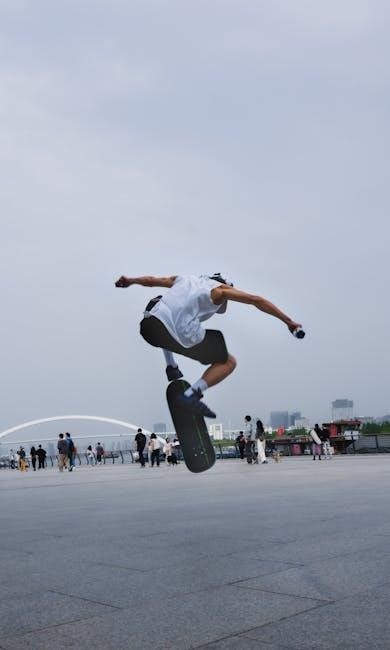The Shonen Jump Guide to Making Manga is a comprehensive resource for aspiring and experienced creators, offering insights from legendary mangaka like Eiichiro Oda and Tite Kubo.
It covers story crafting, character design, and artistic techniques, making it a must-have for anyone passionate about creating compelling manga.
Overview of the Guide
The Shonen Jump Guide to Making Manga is a detailed handbook crafted by the editorial team of Weekly Shonen Jump, offering insights into the creation of compelling manga. It features contributions from renowned creators like Eiichiro Oda, Tite Kubo, and others, sharing their expertise on storytelling, character development, and artistic techniques. The guide covers essential topics such as brainstorming ideas, structuring narratives, and refining visual elements. Additionally, it provides practical advice on breaking into the manga industry and navigating its challenges. This resource is invaluable for both aspiring artists and seasoned professionals, serving as a bridge between creativity and professional success in the world of manga.
Importance of Shonen Jump in Manga Culture
Shonen Jump has long been a cornerstone of manga culture, publishing iconic series like Dragon Ball, One Piece, and My Hero Academia. Its influence spans decades, shaping global manga fandom and inspiring countless creators. The Shonen Jump Guide to Making Manga reflects this legacy, offering insights from industry legends and editors. It serves as a bridge between fans and professionals, fostering creativity and professionalism. By sharing expertise from top mangaka, the guide highlights Shonen Jump’s role in nurturing talent and driving innovation in the manga world. Its impact continues to resonate, making it a vital resource for understanding manga’s cultural significance and artistic evolution.

Creative Process and Story Development
The Shonen Jump Guide to Making Manga dives into the creative process, offering insights into story ideation and development from industry legends, helping creators craft engaging narratives.
Brainstorming and Ideation Techniques
The Shonen Jump Guide to Making Manga provides practical techniques for brainstorming and ideation, helping creators generate compelling ideas. It emphasizes the importance of free writing and mind mapping to explore concepts. Editors and mangaka share their approaches to developing unique story hooks and characters. The guide also highlights the value of collaboration, offering insights into how to effectively bounce ideas with peers or mentors. By focusing on creativity and structure, these methods enable artists to transform raw ideas into engaging narratives. Whether you’re a novice or a seasoned creator, these techniques offer a clear path to crafting stories that captivate audiences.
Structuring a Compelling Narrative
The Shonen Jump Guide to Making Manga dives into the art of structuring a compelling narrative, offering insights from industry veterans. It explores the importance of a strong three-act structure, pacing, and character development. Editors and creators share techniques for building tension, resolving conflicts, and maintaining reader engagement. The guide emphasizes the role of clear storytelling goals and the balance between action and emotional depth. By breaking down successful narratives from iconic series, it provides practical advice for crafting stories that resonate with audiences; These strategies help creators transform ideas into engaging, memorable tales that leave a lasting impact.

Character Design and Development
The Shonen Jump Guide to Making Manga focuses on crafting memorable characters, blending personality and visual appeal to create relatable and engaging protagonists and antagonists for all skill levels.
Creating Memorable and Relatable Characters
The Shonen Jump Guide to Making Manga emphasizes the importance of crafting characters with depth and relatability. Renowned creators like Eiichiro Oda and Tite Kubo share insights into blending unique visual designs with compelling personalities. The guide highlights techniques for developing characters with distinct traits, ensuring they resonate emotionally with readers; Practical examples and exercises are provided to help creators refine their character development skills, focusing on backstory, motivation, and emotional expression. This section is designed to inspire both newcomers and seasoned artists to create characters that stand out and leave a lasting impression in their stories.
Designing Visually Appealing Protagonists and Antagonists
Designing visually appealing protagonists and antagonists is crucial for engaging readers. The Shonen Jump Guide to Making Manga provides expert tips on balancing simplicity with distinctiveness. Legendary creators like Eiichiro Oda and Tite Kubo discuss how to craft characters with iconic silhouettes and expressive features. Protagonists should exude relatability and heroism, often through vibrant colors and dynamic poses, while antagonists can use darker tones and imposing designs to convey menace. The guide emphasizes avoiding overly complex designs to maintain clarity. By focusing on these visual storytelling principles, creators can ensure their characters captivate audiences and leave a lasting impression.

Visual Storytelling and Panel Layout
The Shonen Jump Guide to Making Manga emphasizes the importance of visual storytelling and panel layout in enhancing narrative flow and reader engagement through strategic arrangement.
Mastering Panel Composition and Flow
Mastering panel composition and flow is crucial for creating dynamic and engaging manga. The Shonen Jump Guide to Making Manga provides expert techniques to guide readers’ eyes seamlessly through scenes.
By balancing visual elements and pacing, creators can convey emotions, build tension, and enhance storytelling. Tips from renowned mangaka, such as Eiichiro Oda and Tite Kubo, offer practical advice on arranging panels to maximize narrative impact. This section emphasizes the importance of visual flow in immersing readers, ensuring each page turn feels natural and impactful. Proper panel composition not only enhances readability but also elevates the overall storytelling experience.
Using Visual Elements to Enhance Storytelling
Visual elements play a vital role in manga storytelling, and the guide offers expert tips on how to use them effectively. Techniques like shading, color, and symbolism are explored.
Renowned creators such as Eiichiro Oda and Tite Kubo share insights on how to convey emotions and themes through imagery. The guide emphasizes the importance of visual storytelling to engage readers and add depth to narratives. By mastering these methods, creators can craft scenes that resonate emotionally and visually, enhancing the overall impact of their manga. These strategies help artists communicate complex ideas seamlessly, making their stories more immersive and compelling for audiences.

Artistic Tips and Techniques
Refine your drawing skills with expert advice on tools, techniques, and creative approaches. The guide provides practical tips to enhance your manga art, from basics to advanced methods.
Refining Your Drawing Skills
Refining your drawing skills is a cornerstone of manga creation, and this guide offers expert advice to help artists of all levels improve. From basic techniques to advanced methods, contributors like Eiichiro Oda and Tite Kubo share insights on enhancing your craft. The guide emphasizes the importance of practice and iteration, providing practical tips on mastering proportions, shading, and dynamic poses. It also explores the use of both traditional and digital tools, ensuring artists can adapt to modern workflows. Whether you’re refining your style or exploring new visual approaches, this section equips you with the skills to bring your manga visions to life effectively.
Advanced Tools and Materials for Manga Creation
The guide dives into the latest tools and materials used by professional mangaka, offering insights into both traditional and digital workflows. From high-quality nib pens to cutting-edge digital software like Clip Studio Paint, the guide explores how these tools can enhance your creative process. It also covers innovative techniques for applying toner, creating dynamic textures, and experimenting with visual effects. Contributors share their favorite materials and tricks for achieving unique artistic styles, ensuring artists have the resources to bring their visions to life with precision and flair. Whether you prefer analog or digital methods, this section provides expert advice to elevate your manga creation process.

Industry Insights and Career Advice
The guide offers expert advice from renowned creators and editors, providing industry insights and career tips for manga professionals and practical strategies for success.
Breaking Into the Manga Industry
Breaking into the manga industry requires persistence, creativity, and a deep understanding of the market. The Shonen Jump Guide offers valuable insights from seasoned creators and editors, providing practical advice on how to stand out. Tips include building a strong portfolio, leveraging online platforms, and understanding industry standards. The guide also emphasizes the importance of networking and collaboration, highlighting opportunities to connect with professionals. By sharing real-world experiences and strategies, it helps aspiring mangaka navigate the competitive landscape and turn their passion into a career. This section is indispensable for anyone aiming to succeed in the dynamic world of manga creation.
Networking and Collaboration Opportunities
The Shonen Jump Guide highlights the importance of networking and collaboration in the manga industry. It offers insights into building professional relationships with editors, writers, and artists. The guide emphasizes the value of workshops, conventions, and online communities to connect with like-minded creators. Collaboration opportunities, such as joint projects or mentorship programs, are also explored. By fostering these connections, aspiring mangaka can gain valuable feedback, refine their craft, and open doors to new opportunities. The guide underscores how these relationships can lead to career advancement and inspire fresh ideas, making it a vital resource for anyone looking to thrive in the manga world.

Legacy of Shonen Jump and Its Impact
Shonen Jump has left an indelible mark on manga culture, launching iconic series like Dragon Ball and One Piece, while inspiring global storytelling and fostering future creators.
Iconic Manga Series and Their Influence
Iconic series like Dragon Ball, One Piece, and Naruto have revolutionized the manga industry, setting new standards for storytelling and character development.
These works, born from Shonen Jump, have inspired countless creators worldwide, shaping modern manga’s dynamic and engaging style.
My Hero Academia and Demon Slayer continue this legacy, blending action, emotion, and relatable protagonists.
Their global success has cemented Shonen Jump’s role as a launchpad for groundbreaking narratives.
Such series not only reflect cultural trends but also drive innovation, ensuring manga’s enduring appeal.
The Role of Shonen Jump in Shaping Modern Manga
Shonen Jump has been instrumental in shaping modern manga by providing a platform for creators to showcase groundbreaking stories.
Its influence spans decades, launching iconic series like Dragon Ball and One Piece, which have redefined storytelling in the medium.
By fostering innovation and encouraging diverse narratives, Shonen Jump has set the standard for engaging and dynamic manga.
Its transition to digital platforms ensures global accessibility, further amplifying its impact.
Through simultaneous English releases and collaborations, Shonen Jump continues to inspire new generations of creators and fans worldwide.



